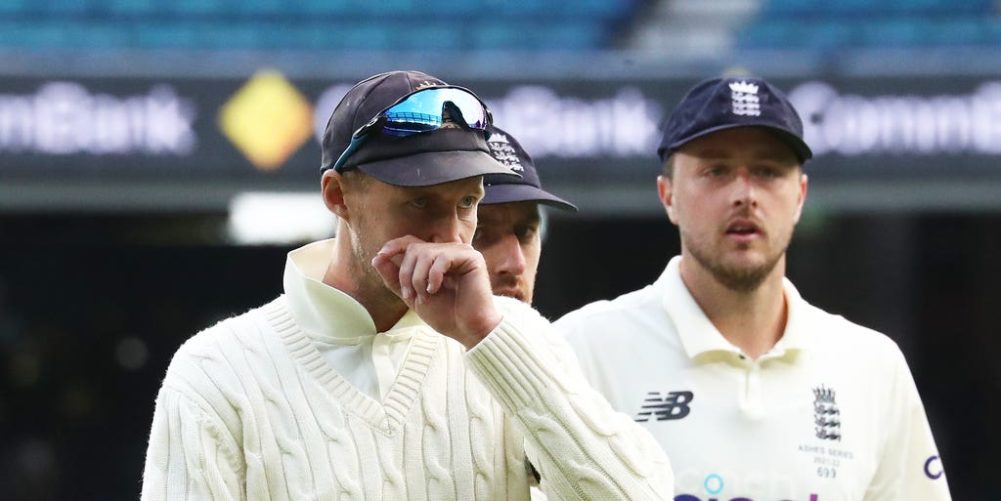Joe Root’s side have won just once in their last 12 games and are the first English team to lose nine in a calendar year. The response has been some familiar questions about the state of the game and what might be done to put it right.
Here, The Cricket Paper take a closer look at some of those issues and asks what can be done to improve things.
Is there an appetite for change?
There are no bigger voices in English cricket than Joe Root and he has come as close to calling for a systemic overhaul as anyone who wears the captain’s blazer is likely to.
Speaking after the gruesome defeat in Melbourne, he said: “You look back at 2015 and the reset that happened in white-ball cricket and maybe that’s something that needs to be happening in our red-ball game as well”.
Head coach Chris Silverwood has been more circumspect but has nodded to “questions” and “conversations” that need to happen after the Ashes concludes, suggesting he sees work to be done.
Could England’s coaching and management be an issue?
In April 2021, England Head Coach Chris Silverwood was entrusted as sole selector of the England cricket team. Since then, England have lost six of their nine Test matches. If it wasn’t for Joe Root’s unbelievable year in which he scored 1,708 Test runs, the third-most in Test history in a calendar year – it would look much bleaker.
Silverwood’s main aim was to win the white ball double with the IT20 World Cup in the autumn. Considering the number of absentees in the squad, agonising defeat to New Zealand in the semi final stage was seen as acceptable.
There is a large number of coaches involved in the England set up that are respected former professionals. Paul Collingwood, Jon Lewis and Marcus Trescothick are part of the wider coaching staff. But, when have any of these coached a county side – where coaches and directors are responsible for results?
Higher up, Ashley Giles is Managing Director of the England side. His tenures with English cricket have been nothing short of a shambles.
Within the circle of ECB coaches, there’s nobody in the ECB friendship group who you can point to and say they can take this team forward. Even at county level, there’s nobody smashing the door down of international coaching.
The focus on white ball cricket since the 2015 World Cup has hindered the progress of England’s Test team. There’s no doubt that it has come to head with England’s abysmal Test year in 2021. Ashley Giles has put all his eggs in Silverwood’s basket and it’s cracked beyond repair.
Is Test cricket still the pinnacle and should it be?
There is no doubt that the five-day format is being squeezed from nearly all sides by the glossy allure of its shorter, snazzier counterparts.
But it remains the ultimate challenge of a cricketer’s credentials and, in England specifically, it pays.
Ticket sales for Test cricket are strong, broadcasters pay well for the long form and, outside of pandemic times, travelling support is enormous (as well as enormously lucrative for host nations).
England play more Tests than anyone, if they don’t fight for it, nobody will.
How bad has it got?
The truth is, England’s Test team has been coasting on the achievements of a handful of greats for far too long.
Joe Root is a batter for the ages, who is tracking to finish as the country’s highest ever run-scorer, while James Anderson and Stuart Broad sit comfortably on top of the all-time wicket-takers list.
Ben Stokes does not have such unimpeachable numbers but has proved himself to be a match-winner like no other and is a genuinely elite all-rounder.
That aside, the pickings are slim. It is years since a player came into the set-up and established themselves as a world-class operator. Instead a conveyor belt of county exports come and go.
What is wrong with the County Championship?
For a number of years there have been complaints that the domestic first-class competition has been shovelled to the edges of the season – with the majority of games played early on or in the first knockings of autumn, rather than the height of summer.
That often translates to green, unpredictable pitches that leave batters skittish, gentle seamers in charge and spinners under-used. In a world where big totals, extreme pace and mystery spin rules the roost, none of these skills are being honed in the county game.
There have been calls to cut the number of First Class counties from 18. According to some, there are too many teams and too many professional players in the English game that are hindering the quality of county cricket.
County cricket is the bedrock of communities. It has been around longer than international cricket – with Sussex County Cricket Club being formed 1839. Is the English domestic structure simply here to aid the development of the England cricket team?
English sport wept as Football League club Bury FC dissolved after 135 years of existence. People now want to do away with half the counties who have been here longer?
Nobody asked for county cricket to be cut when it played a huge role in the development of a golden generation of England Test cricketers from 2009-2013 – where they won three Ashes series and topped the ICC Test rankings. Or, when it aided the development of England’s white ball players to win the 2019 ICC World Cup. It simply cannot be blamed.
So why not shuffle the dates?
It appears the England and Wales Cricket Board will provide more championship matches in the peak months next year, but decisions elsewhere mean it can only go so far.
The decision to create a ring-fenced block for The Hundred is great news for broadcast partners, who have an easily digestible window to sell, but it means other formats can be crowded out.
Introducing a new format and keeping both the 50-over and Twenty20 tournaments simply creates too much white-ball cricket. Something must give. Counties need the Vitality Blast T20 competition from a commercial perspective. Without the Blast, there will be no county cricket.
Possible ideas the three divisions of six teams that play home and away. However, this alienates 12 of the 18 counties who effectively play for nothing. It didn’t work in the 2020 season.
Other possible ideas that have been vocalised by Michael Vaughan in the past, is that county cricket could play two rounds of fixtures in warmer climates in March. Most teams travel away for pre season to the UAE or Spain for warm weather training, why not play matches in different conditions? It will aid player development as they will play on different wickets to those in England. It also helps ease pressure on the schedule as there’s eight less days to contend with. It
Members will lose out on four days cricket in the year. A small price to pay for the continuation of something they love. No cricket fan wants to see a reduction of the number of counties. The impressing development of live streaming means that these matches can still be viewed.
In 2018, Jonathan Liew wrote: “If the Hundred fails it’ll be a disaster. If it succeeds – it’ll be a catastrophe”.
Is the IPL a problem?
The ECB’s relationship with the Indian T20 circus has certainly changed from the time that it caused a breakdown in relations with star player Kevin Pietersen.
Nowadays, handfuls of players are signed off to take up franchise deals even if that means missing out on a few hard yards on the county circuit or – in 2021 – sitting out a series against World Test champions New Zealand.
The genie is out of the bottle at this stage, but the best English players facing each other in county action raises the standard for everyone.
Prominent players such as Jos Buttler and Jonny Bairstow play little to no First Class cricket due to IPL contracts and white ball commitments. The only place they can work on their game is in the middle during a Test match. How can this result in anything other than failure?
Anything else while we’re here?
Yes. England play too much international cricket. The treadmill simply never stops.
Next winter alone they have five separate touring commitments. Is it really a surprise that players get chewed up and spat out of a system that never allows for proper down time or a chance to work on technical aspects away from the pressure cooker of elite competition?
Nobody at the ECB has ever shown any inclination to dial down the fixture list, with the balance sheet too dependent on a constant diet of games. Where quality is concerned, sometimes less is more.
Cricket has been in the news for all the wrong reasons in the lead up to The Ashes with the Yorkshire racism scandal. In a year where The Hundred was introduced to make the game more accessible, elitism and racism has made the game feel the least accessible it may have ever been.
Below, Tom Brown highlights the issues of talent ID and development in the game that are not helping English cricket:
Losing the Ashes in a meagre 12 days has brought more finger pointing. Some people want heads and change. Will big changes help the England team moving forward? If Silverwood is to go, who can replace him? Will it improve the side?
PA Sport Staff and The Cricket Paper















